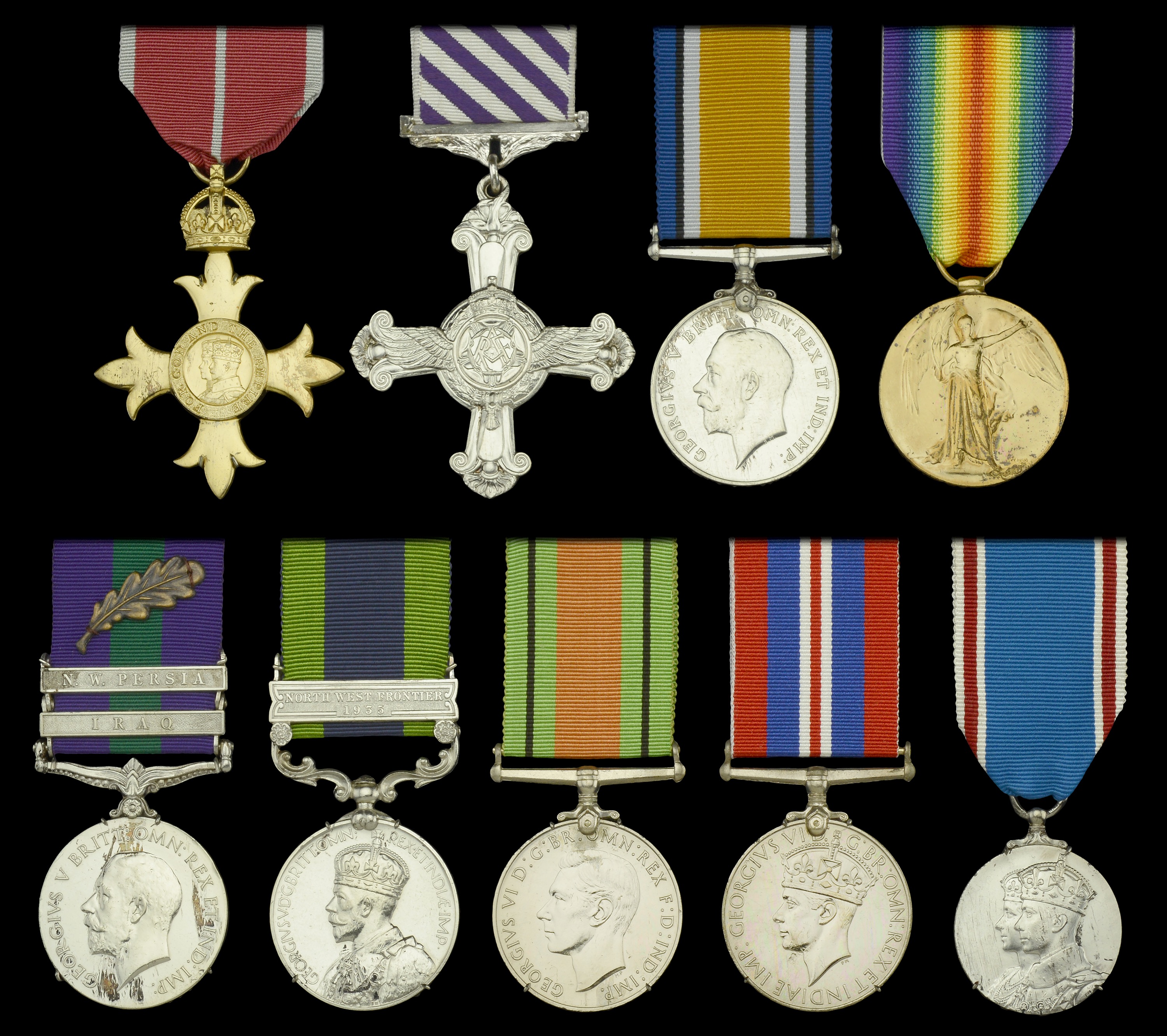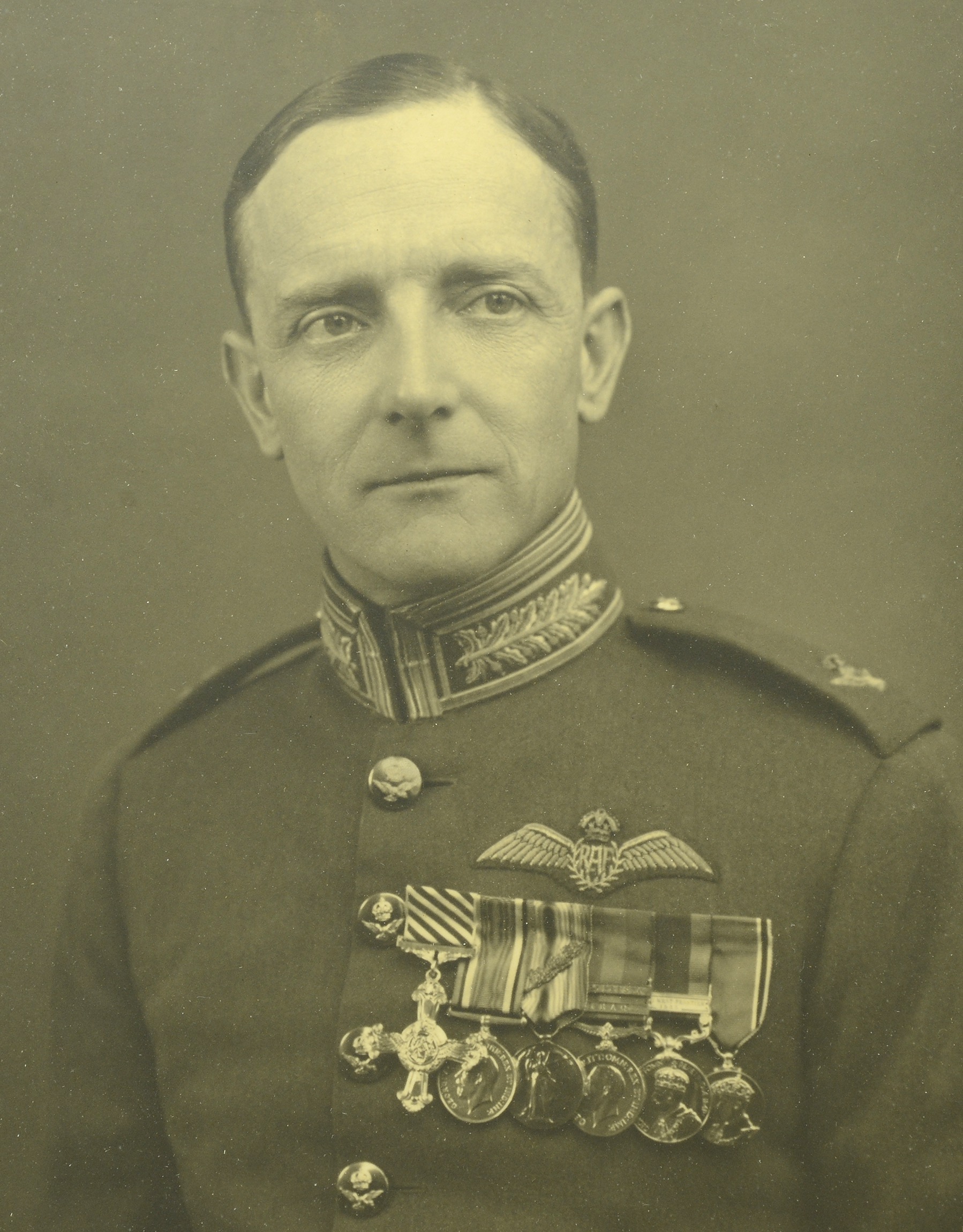70
The extremely rare and superb '1940' military division O.B.E., 1935 'North West Frontier -...
Bids do not include VAT, buyer’s premium or delivery.
By confirming your bid, you agree that you have read and accepted the-saleroom.com and the auctioneer's terms and conditions. Confirming your bid is a legally binding obligation to purchase and pay for the lot should your bid be successful.
Choose one of the quick bid options below:
Bids do not include VAT, buyer’s premium or delivery.
By confirming your bid, you agree that you have read and accepted the-saleroom.com and the auctioneer's terms and conditions. Confirming your bid is a legally binding obligation to purchase and pay for the lot should your bid be successful.
Battle returned to the UK, and was employed as a Test Pilot at A & A.E.E., Martlesham Heath, October 1922 - April 1926. Having flight tested a large number of different aircraft, Battle was posted for operational flying on the North West Frontier. An extremely experienced pilot of mountainous and difficult terrain, Battle commanded 39 and 11 Squadrons - leading the Hawker Hart bombers of the latter during the Mohmand Operations of August - October 1935. His varied and distinguished flying career being well documented in his part autobiography - Line! The Reminiscences of a Royal Air Force Pilot.
The Most Excellent Order of the British Empire, O.B.E., (Military) Officer’s 2nd type, breast badge, silver-gilt; Distinguished Flying Cross, G.V.R., reverse additionally engraved ‘Sqd. Ldr. H. F. V. Battle.’; British War and Victory Medals (2. Lieut. H. F. V. Battle. R.A.F.); General Service 1918-62, 2 clasps, Iraq, N.W. Persia, with M.I.D. oak leaf (F/L. H. F. V. Battle. R.A.F.) minor edge bruise; India General Service 1908-35, 1 clasp, North West Frontier 1935 (F/L. H. F. V. Battle. R.A.F.); Defence and War Medals 1939-45, both privately engraved ‘A/Cdre. H. F. V. Battle.; Coronation 1937, last engraved ‘H. F. V. Battle.’, housed in a custom-made glazed wooden Spink & Son, St. James display case, lacquered, generally very fine or better (9) £4,000-£5,000
---
O.B.E. London Gazette 11 July 1940:
‘In recognition of distinguished service in operational commands.’
D.F.C. London Gazette 8 May 1936:
‘For gallant and distinguished service rendered in connection with the Mohmand Operations on the North West Frontier, India, during the period 15/16th August to 15/16th October 1935.’
M.I.D. London Gazette 28 October 1921 (Iraq).
Notation in Records - Air Ministry Order No. 439/1924 (and notation made in record of service):
‘Brought to notice in recognition of distinguished services in Iraq, 1922’
Only 4 D.F.C.’s were awarded for the 1935 operations, with Battle’s being approved and invested by King Edward VIII at Buckingham Palace, 14 July 1936. This, the only award to 11 Squadron, was among the last of the G.V.R. crosses to be awarded.
Henry Frederick Vullimay Battle was born in September 1899, and the son of a Surgeon, resided in Harley Street, London. He was educated at Highfield School, and he was one of five children. Battle’s elder brother Edward was killed in action whilst serving with the Worcestershire Regiment in October 1914:
‘Once Henry had overcome this shock he decided that he would shoot down as many Huns as the good Lord would let him, and so, as the months went by, he concentrated on learning about air tactics as described in the biographies of the great fighter pilots of both sides, and visited Hendon as often as he could during the holidays, to study the art of flying.’ (Line! The Reminiscences of a Royal Air Force Pilot, the recipient’s autobiography (throughout which he refers to himself in the third person) refers)
Battle was employed as a Special Apprentice at the Royal Aircraft Factory, South Farnborough, July - September 1917, and joined the Royal Flying Corps, 19 September 1917. He carried out pilot training at Beaulieu and Turnberry, and was awarded Royal Aero Club Certificate No. 6463 in February 1918. Battle was posted for operational flying with 60 Squadron (S.E.5’s), Boffles, near Auxi-le-Chateau, France:
‘Five days later my posting to No. 60 Squadron came through, and that night, I was on my way to join one of the two most famous fighter squadrons on the Western Front (the other was No. 56). Both Ball and Bishop had been members of No. 60, and it will be remembered that McCudden, another V.C., was on his way to that unit when he was killed.’ (Ibid)
Battle served with ‘C’ Flight (commanded by Captain B. McEntegart) 60 Squadron on the Western Front, August - September 1918:
I was soon able to own a bed in one of the small Nissen huts, which could just hold four beds each. I had not moved in long before I did my best to set fire to the hut. A new French petrol lighter bought in Boulogne burst into flames when I tried to light a cigarette. The only other living thing in the hut at the time was the squadron mascot, a small black terrier called Hispano, which immediately got into top gear and chased its tail round the hut until I had opened the door and kicked the flaming lighter out on to the grass. Hispano was a very popular character, but suffered from the loss of one eye, sustained in the course of his favourite game of mole hunting.’ (Ibid)
Battle carried out numerous offensive patrols:
‘’C’ Flight now settled down, as the weather improved, to two sorties a day, one usually at dawn and another in the afternoon or evening. The dawn patrols I rather liked. It was not fun getting up in the dark with old ‘Chu Chin Chow’ [the orderly] knocking us up, but I liked getting into my cockpit just as the sky was lighting up and taking off in formation when one could just see the edge of the field ahead, flames and sparks streaming out of our shortened exhaust pipes, then rising into the sunlight before it had reached the ground.
Unlike my first sortie, most of our subsequent patrols were done at about 16,000 feet, always over the German side of the lines. We saw very little except the occasional large enemy formations which always appeared well above us. But our main concern was to avoid being shot down by enemy A.A. fire. We soon found out that the best shooting was done by a battery near Havrincourt Wood, and I was told then that this battery and another near Ostend were the two best which the Germans possessed. It must be admitted that on occasions the shells burst so close that I instinctively put an arm up in a pathetic attempt to protect myself.’ (Ibid)
Saved By a ‘Comfortable Seat’
Battle moved with the Squadron to Baisieux, near Albert in September 1918. After his birthday on 18 September 1918:
‘I started experimenting in seating arrangements [during Offensive Patrols] and found that an extra cushion under my posterior gave me a much better field of view... The Destiny decided to take a hand in our daily games of hide-and-seek. I got up as usual for the dawn patrol... We stooged around as before at about 16,000 feet and saw the usual enemy formations above us, the sun glinting off them every now and then as they wheeled around. At this point I decided that there were too many cushions under me and I was feeling the cold. I was sitting on three and as a modification the third cushion was a failure, but it undoubtedly saved my life.
Suddenly eight Huns peeled off from their parent formation and dived onto our tails. Immediately Mac [McEntegart] started a dive away left, with my hanging on to the formation with full engine on. Then, at 12,000 feet my attention was drawn by an astounding sight. Streams of smoke poured past me and then I realised someone was firing at me. I immediately yan...
Battle returned to the UK, and was employed as a Test Pilot at A & A.E.E., Martlesham Heath, October 1922 - April 1926. Having flight tested a large number of different aircraft, Battle was posted for operational flying on the North West Frontier. An extremely experienced pilot of mountainous and difficult terrain, Battle commanded 39 and 11 Squadrons - leading the Hawker Hart bombers of the latter during the Mohmand Operations of August - October 1935. His varied and distinguished flying career being well documented in his part autobiography - Line! The Reminiscences of a Royal Air Force Pilot.
The Most Excellent Order of the British Empire, O.B.E., (Military) Officer’s 2nd type, breast badge, silver-gilt; Distinguished Flying Cross, G.V.R., reverse additionally engraved ‘Sqd. Ldr. H. F. V. Battle.’; British War and Victory Medals (2. Lieut. H. F. V. Battle. R.A.F.); General Service 1918-62, 2 clasps, Iraq, N.W. Persia, with M.I.D. oak leaf (F/L. H. F. V. Battle. R.A.F.) minor edge bruise; India General Service 1908-35, 1 clasp, North West Frontier 1935 (F/L. H. F. V. Battle. R.A.F.); Defence and War Medals 1939-45, both privately engraved ‘A/Cdre. H. F. V. Battle.; Coronation 1937, last engraved ‘H. F. V. Battle.’, housed in a custom-made glazed wooden Spink & Son, St. James display case, lacquered, generally very fine or better (9) £4,000-£5,000
---
O.B.E. London Gazette 11 July 1940:
‘In recognition of distinguished service in operational commands.’
D.F.C. London Gazette 8 May 1936:
‘For gallant and distinguished service rendered in connection with the Mohmand Operations on the North West Frontier, India, during the period 15/16th August to 15/16th October 1935.’
M.I.D. London Gazette 28 October 1921 (Iraq).
Notation in Records - Air Ministry Order No. 439/1924 (and notation made in record of service):
‘Brought to notice in recognition of distinguished services in Iraq, 1922’
Only 4 D.F.C.’s were awarded for the 1935 operations, with Battle’s being approved and invested by King Edward VIII at Buckingham Palace, 14 July 1936. This, the only award to 11 Squadron, was among the last of the G.V.R. crosses to be awarded.
Henry Frederick Vullimay Battle was born in September 1899, and the son of a Surgeon, resided in Harley Street, London. He was educated at Highfield School, and he was one of five children. Battle’s elder brother Edward was killed in action whilst serving with the Worcestershire Regiment in October 1914:
‘Once Henry had overcome this shock he decided that he would shoot down as many Huns as the good Lord would let him, and so, as the months went by, he concentrated on learning about air tactics as described in the biographies of the great fighter pilots of both sides, and visited Hendon as often as he could during the holidays, to study the art of flying.’ (Line! The Reminiscences of a Royal Air Force Pilot, the recipient’s autobiography (throughout which he refers to himself in the third person) refers)
Battle was employed as a Special Apprentice at the Royal Aircraft Factory, South Farnborough, July - September 1917, and joined the Royal Flying Corps, 19 September 1917. He carried out pilot training at Beaulieu and Turnberry, and was awarded Royal Aero Club Certificate No. 6463 in February 1918. Battle was posted for operational flying with 60 Squadron (S.E.5’s), Boffles, near Auxi-le-Chateau, France:
‘Five days later my posting to No. 60 Squadron came through, and that night, I was on my way to join one of the two most famous fighter squadrons on the Western Front (the other was No. 56). Both Ball and Bishop had been members of No. 60, and it will be remembered that McCudden, another V.C., was on his way to that unit when he was killed.’ (Ibid)
Battle served with ‘C’ Flight (commanded by Captain B. McEntegart) 60 Squadron on the Western Front, August - September 1918:
I was soon able to own a bed in one of the small Nissen huts, which could just hold four beds each. I had not moved in long before I did my best to set fire to the hut. A new French petrol lighter bought in Boulogne burst into flames when I tried to light a cigarette. The only other living thing in the hut at the time was the squadron mascot, a small black terrier called Hispano, which immediately got into top gear and chased its tail round the hut until I had opened the door and kicked the flaming lighter out on to the grass. Hispano was a very popular character, but suffered from the loss of one eye, sustained in the course of his favourite game of mole hunting.’ (Ibid)
Battle carried out numerous offensive patrols:
‘’C’ Flight now settled down, as the weather improved, to two sorties a day, one usually at dawn and another in the afternoon or evening. The dawn patrols I rather liked. It was not fun getting up in the dark with old ‘Chu Chin Chow’ [the orderly] knocking us up, but I liked getting into my cockpit just as the sky was lighting up and taking off in formation when one could just see the edge of the field ahead, flames and sparks streaming out of our shortened exhaust pipes, then rising into the sunlight before it had reached the ground.
Unlike my first sortie, most of our subsequent patrols were done at about 16,000 feet, always over the German side of the lines. We saw very little except the occasional large enemy formations which always appeared well above us. But our main concern was to avoid being shot down by enemy A.A. fire. We soon found out that the best shooting was done by a battery near Havrincourt Wood, and I was told then that this battery and another near Ostend were the two best which the Germans possessed. It must be admitted that on occasions the shells burst so close that I instinctively put an arm up in a pathetic attempt to protect myself.’ (Ibid)
Saved By a ‘Comfortable Seat’
Battle moved with the Squadron to Baisieux, near Albert in September 1918. After his birthday on 18 September 1918:
‘I started experimenting in seating arrangements [during Offensive Patrols] and found that an extra cushion under my posterior gave me a much better field of view... The Destiny decided to take a hand in our daily games of hide-and-seek. I got up as usual for the dawn patrol... We stooged around as before at about 16,000 feet and saw the usual enemy formations above us, the sun glinting off them every now and then as they wheeled around. At this point I decided that there were too many cushions under me and I was feeling the cold. I was sitting on three and as a modification the third cushion was a failure, but it undoubtedly saved my life.
Suddenly eight Huns peeled off from their parent formation and dived onto our tails. Immediately Mac [McEntegart] started a dive away left, with my hanging on to the formation with full engine on. Then, at 12,000 feet my attention was drawn by an astounding sight. Streams of smoke poured past me and then I realised someone was firing at me. I immediately yan...
Orders, Decorations, Medals and Militaria
Sale Date(s)
Venue Address
General delivery information available from the auctioneer
If you are successful in purchasing lot/s being auctioned by us and opt for the item/s to be sent to you, we will use the following methods of shipment:
Within the UK
If you live within the UK, items will be despatched using Royal Mail Special Delivery. This service provides parcel tracking (via the Royal Mail website) and next weekday delivery (betwen 9am and 1pm). Items delivered within the UK are covered by our insurance company. Heavy and bulky lots will be sent by courier, in discussion with the client.
Outside of the UK
If the item/s being sent are worth under £1000 in total they are sent using Royal Mail’s Signed For International service. This ensures the item must be signed for when it is delivered.
If the item/s being sent are valued at over £1000 in total they will be sent using FedEx. This service allows next day delivery to customers in many parts of the US and parcels are fully trackable using the FedEx website.
Shipping Exceptions
Certain lots such as those containing glass or sharp implements, etc., may not be suitable for in-house shipping within or outside of the UK. Please contact Noonans with any queries.
Important Information
Auctioneer's Buyers Premium: 24% (+VAT)
There is an additional charge of 4.95% (+VAT/sales tax)














